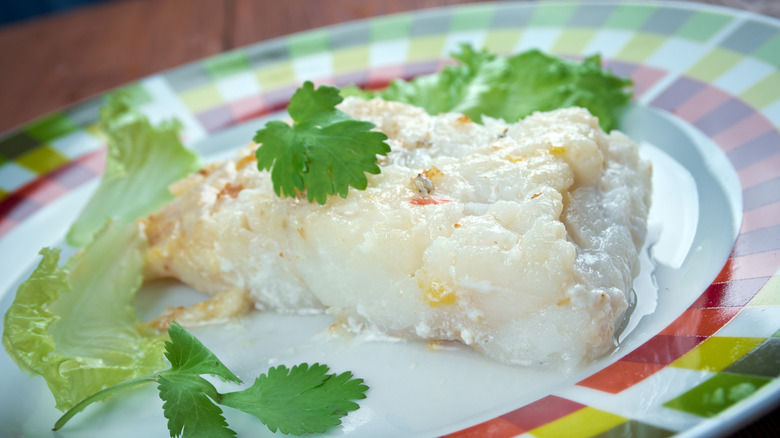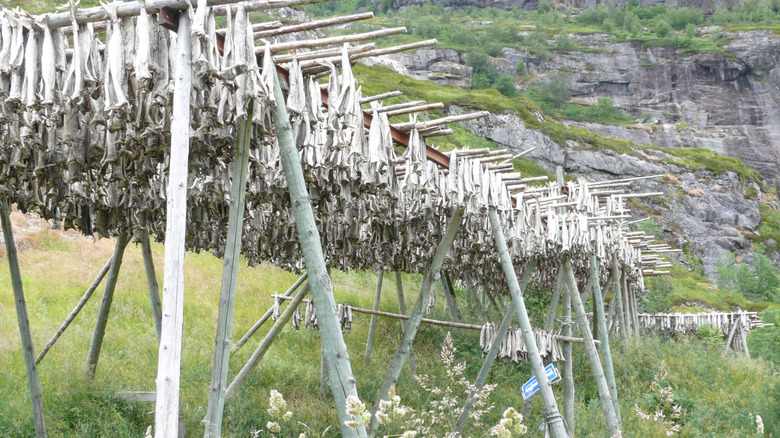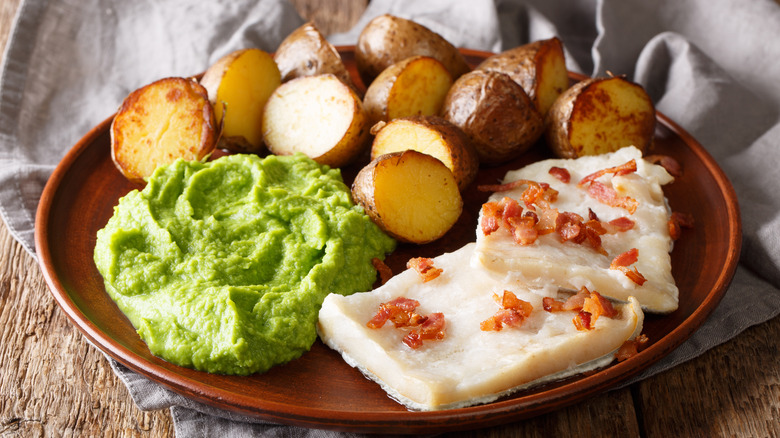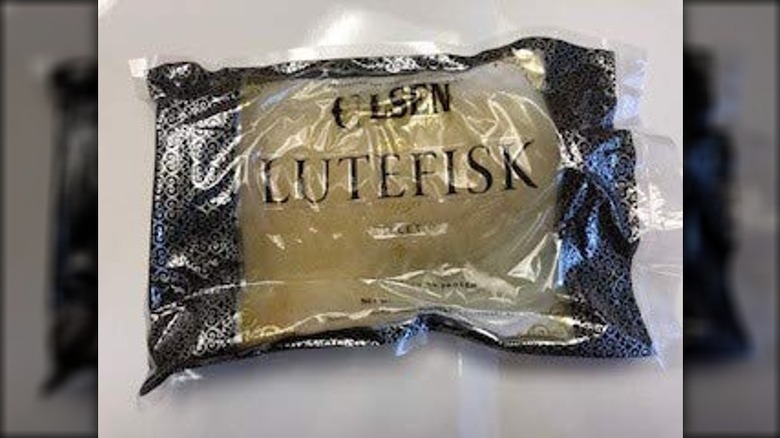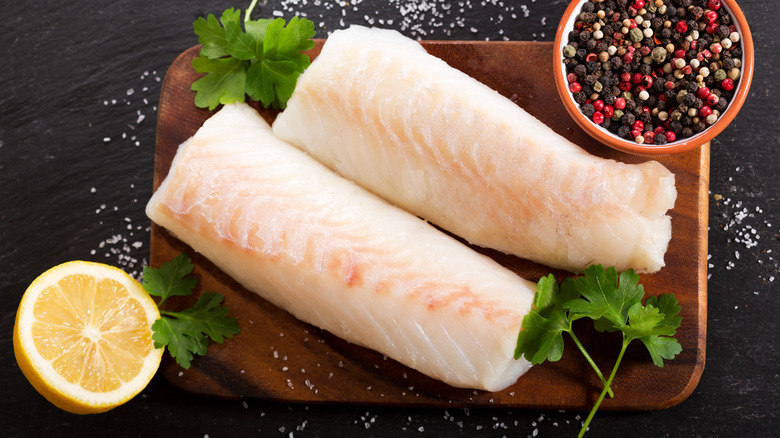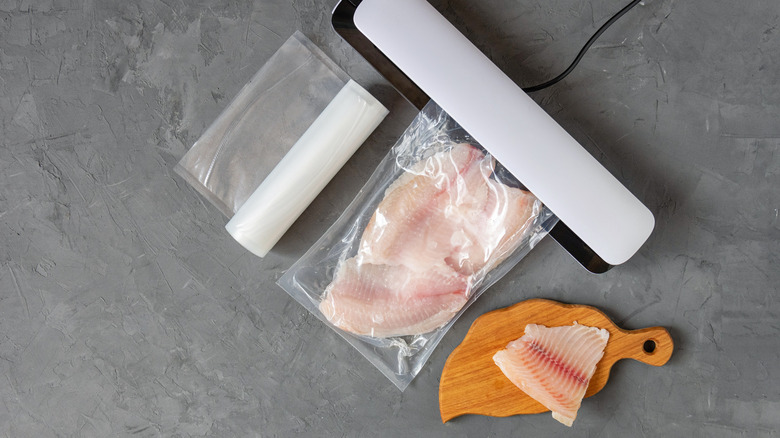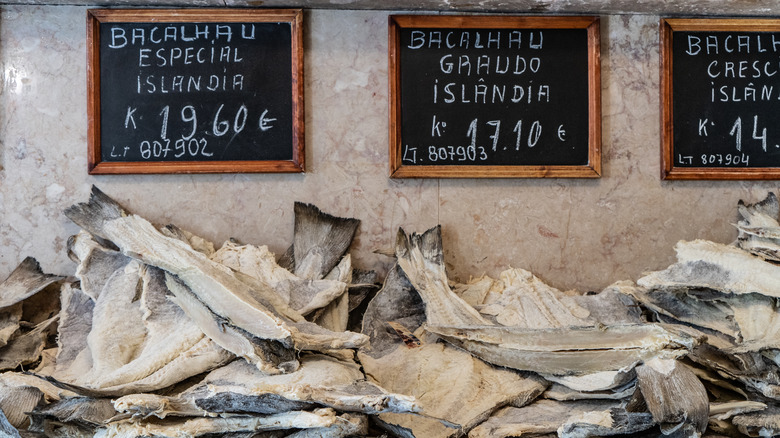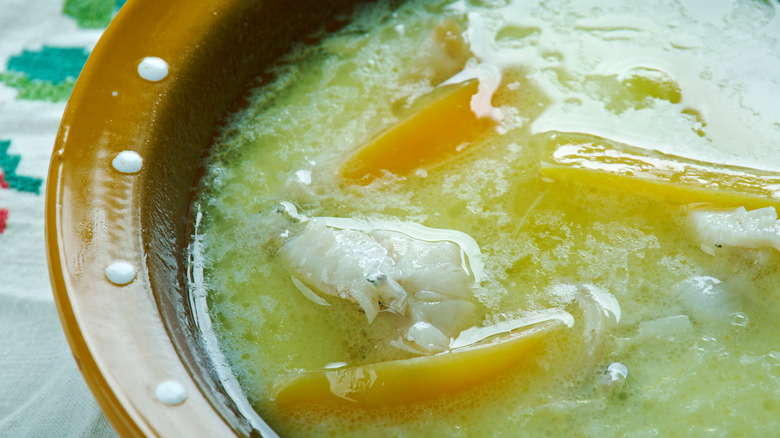What In The Heck Is A Lutefisk, And Why Do Minnesotans Eat It?
The problem of preserving food, particularly fresh meat and fish, has been at the forefront of human survival for thousands of years. Accessing a reliable and affordable protein source is critical, but having fresh meat and fish isn't always feasible, which is why humans developed techniques like freezing, canning, smoking, and pickling. One of the earliest recorded examples of the preservation of meat dates back to Mesopotamia, around 3000 B.C. There, meat and fish were salted, dried, and stored in oil. And by 200 B.C., Greeks and Romans had perfected the art of salt curing.
While modern science understands that moisture encourages the proliferation of bacteria in meat, early civilizations were keen observers. They were able to assess that meat left out in the elements would quickly develop an off odor and encourage the attention of bugs. They also witnessed that meat naturally dehydrated was edible for an extended period. This observation led Scandinavians to leave cod, or stockfish, out in the freezing weather to preserve them. The dried fish could last years and was easily portable for this seafaring culture. This early heritage of drying cod is the origin of what is known as the delicacy lutefisk, or lutfisk, among Swedes. Let's take a closer look at what in the heck lutefisk is, as well as why Minnesotans seem to be addicted to it.
What is lutefisk?
Lutefisk (pronounced Lewd-uh-fisk) translates to "lut" ("lye") and "fisk" ("codfish"). This air-dried codfish is soaked in a lye solution for a few days and then washed in cold water to reconstitute it. The result has a gelatinous texture and a smell redolent of ammonia. Often called lyefish in the U.S., this delicacy made its way to the U.S. via Scandinavian immigrants.
While nobody knows with certainty where lutefisk originated, what is certain is that salt was not a readily available natural resource in Scandinavia, preventing salt curing from evolving as a preservation method until the 1700s. According to legend, the Vikings were notorious for plundering and pillaging villages throughout Scandinavia. On one particularly unfortunate day, the Vikings decimated one such hamlet. Villagers returning to their homes ablaze put out the fire with water. One of the items caught up in the fire was dried cod stored on wooden racks. As the embers settled and ash heaps coated the dried cod, rain befell the village. These dried codfish had now gotten submerged in a pool of lye.
When these fish got unearthed, villagers noticed the fish had swelled to what looked like freshly caught fish. Hungry and desperate for something to eat, the villagers soaked these bloated codfish in water until they felt it would be safe to boil and eat. According to the legend, one poor brave soul took a leap of faith and sampled the fish, pronouncing it edible. The rest is history.
How is lutefisk made?
Historically, lutefisk was made by taking freshly caught cod or stockfish, abundant in the cold waters surrounding Norway, and allowing the fish to dry in the cold arctic air. This air-dried fish is known as tørrfisk. Once dehydrated, these fish would shrivel to one fifth their original size, developing a texture similar to shoe leather. To eat the dried fish, they needed to get rehydrated. One could rehydrate simply by soaking in water, but doing so took a very long time and was extremely labor intensive.
Enter the use of lye. According to The Norwegian American, not only does lye expedite the rehydration process, but it also improves the digestibility and nutritional content of the fish by breaking down the amino acids in its protein, rendering it far more readily absorbable in the small intestine. The use of lye is not unique to Scandinavia. Several indigenous cultures also use lye, including those of the U.S. and Mexico, which would soak corn in lye to increase the calcium and niacin in the corn. Untreated corn does not release niacin, thereby putting those relying upon it for their primary source of nutrition at risk for developing pellagra.
Modern-day lutefisk is no longer something typically made in-house but industrially produced in factories using commercial kilns to dry the fish and refined lye, which yields a less malodorous and aggressively flavored end product. The lutefisk is generally vacuum-sealed and sold in grocery stores for immediate use.
What does lutefisk taste like?
It would be hard to discuss the taste of lutefisk without addressing its distinct smell and texture. Indeed, it is something you either love or hate, often depending upon if you can get past its smell to give the taste a chance. As a general rule of thumb, even after multiple soakings in water to remove the stench of lye, a residual chemical fetor remains, which may be more or less pronounced depending on how the fish gets cooked but is always there to one degree or another. Bob Sturgeon, president of the Vegas Viking Lodge, told the Las Vegas Review-Journal that two factors may influence the smell. First, authentic Norwegian cod is far more potent than modern variations made of pollock or haddock. Additionally, those producers who opt for birch ash over lye in processing the lutefisk yield a much more palatable product.
Now that you have gotten past the odor, the texture is less like biting into a piece of fish and more like doing a Jell-O shot. The rehydration process creates a very moist fish that melts in your mouth. Some people enjoy this, and others despise it. Even if you enjoy eating softer flesh fish like halibut, this is distinct from that.
And the taste? While this isn't the most satisfying description, the taste can best be characterized as a "fishy fish." For those growing up consuming other preserved fish, like pickled herring, you will likely enjoy lutefisk. If not, you may decide to skip it.
How to cook with lutefisk
How you cook lutefisk may make or break your first experience eating it. The process in which you prepare it, combined with any accompanying sauces, can transform this delicacy into something more appealing. Lutefisk can be cooked in four distinct ways. First, it can be poached, wrapped in cheesecloth to avoid disintegration. Second, it can get baked in the oven on high heat. Third, it can get roasted in a broiling pan under high heat. And lastly, it can get microwaved. The microwave is quick and easy, but the two methods that yield the best results are poaching and baking.
Next comes the sauce, which is crucial with a low-fat fish like cod. It may sound cliché, but as per usual, bacon makes everything better. Bacon fat coats the fish beautifully, and the umami-rich flavor profile of the bacon helps to offset any off-putting smell. Another delightful alternative would be a compound butter made with fresh herbs.
And no matter how you prepare the lutefisk, be sure to eat it with plenty of homemade lefse, a type of Norwegian pancake made of either wheat or potatoes. You can either make it yourself or purchase it via a Scandinavian grocer. Place the lutefisk onto the lefse, drizzle your sauce of choice over the fish, and then roll the lefse up like a tube. Side dishes served always include mashed potatoes and peas.
Where to buy lutefisk
While some grocery stores carry lutefisk, it is something of a novelty item more likely to be found in areas heavily populated by individuals of Scandinavian heritage. It is somewhat seasonal, as most people consume lutefisk as a Christmas treat. If a local grocer does have lutefisk, it will likely be in the frozen food section in vacuum-sealed pouches in 2- to 3-pound portions. This lutefisk is usually "kettle ready," meaning it is ready to cook without requiring extensive soaking and preparation. However, double-check the packaging for preparation directions to ensure safety and quality.
That said, online purveyors are plentiful and reliable. Because they usually specialize in producing lutefisk and Scandinavian gourmet products, their quality is high, and their prices are affordable. Some offer fresh and frozen options, with sizes ranging from individual portions to bulk portions intended for large gatherings. Price will vary with both quantity and quality. While most recipes suggest using 1 pound of meat per person, that's a lot of fish, especially lutefisk. For first-timers, consider ½ pound per person to avoid wasting it.
If possible, search for authentic Norwegian cod and lutefisk soaked in birch ash versus lye. Planet Norway warns that, whatever you do, never attempt to make lutefisk on your own. If you accidentally get the concentration of lye wrong, you can end up with a toxic piece of fish. It is always best to purchase lutefisk from qualified and experienced purveyors.
Nutritional information about lutefisk
Cod is a low-fat protein source that has been the staple of the diets of many cultures throughout history. A good source of omega-3 fatty acids, vitamin B12, and iodine, a single 4-ounce serving is only 93 calories. Lutefisk may be even more nutritious thanks to the lye breaking down the proteins in the fish, allowing them to get more easily absorbed by the small intestine (via The Norwegian American).
Nutritional value aside, another aspect of consuming lutefisk must be considered — safety. Once lutefisk has finished soaking in lye, it can have a pH level of between 11 and 12, which is unsafe to eat and potentially lethal (via BootsnAll). Proper preparation involving soaking the lutefisk for several days in fresh water that's continuously changed will render it perfectly safe to eat. However, be sure the person preparing it knows what they're doing.
Additionally, even after being soaked, residual lye from lutefisk can stain silverware and cookware unless immediately cleaned after eating. Purchasing kettle ready lutefisk will eliminate some of this risk, although we still recommend caution in preparation.
How to store lutefisk
The entire purpose of drying fish, to begin with, is to preserve it for long-term storage. That said, lutefisk soaked in lye is a slightly different creature. The lye does not get used to prolong the shelf life of the fish in any capacity. As with other fish, we recommend only keeping fresh lutefisk in the refrigerator for two days. Properly vacuum-sealed fish may give you slightly longer, up to three days. For best quality and safety, we recommend freezing your lutefisk whether you buy it fresh or vacuum-sealed.
Be sure to properly package your lutefisk before freezing. Experts recommend that fish be double-wrapped in plastic wrap, surrounded in freezer paper, then placed in a plastic freezer bag to prevent freezer burn. Once frozen, leaner fat fish, like cod, may get stored in the freezer for up to six months. Even with these basic guidelines, carefully follow any packaging instructions on storage, thawing, preparation, and cooking lutefisk. Each purveyor will know their product best and should provide proper care instructions for safety and quality.
What is the difference between lutefisk and bacalhau?
While lutefisk and bacalhau are both types of dried cod, one ingredient separates the two — salt. Historically, Scandinavian countries lacked local salt sources, making salt curing impossible. Fortunately, the frigid temperatures of the climate in Nordic countries enabled the fish to be dried without it, though it took significantly longer. This air-dried fish (tørrfisk) took longer to rehydrate, which is where the use of lye came into play. It helped keep bacterial development at bay for as long as it took for the dried cod to rehydrate.
Bacalhau, on the other hand, is a salt-cured dried cod. The Portuguese popularized this technique during the 1500s, first as means of preserving fish they caught off the coast of Canada, then as a means of accommodating for the warm, humid climate of the Iberian Peninsula, which was not well suited to air-drying cod. A solution to mitigating bacterial formation in the fresh fish involved salting and packing pieces of fresh cod in layers in barrels. They would soak in this brine until approximately 40% of their moisture got removed. Once this occurred, the salted cod would be removed from the barrel and dried until the moisture content was reduced by an additional 20%. That low moisture content made the cod shelf-stable for long cross-Atlantic voyages. Salt-cured cod can be rehydrated in just two days, making it an easier product to use and one that's less offensive to the nasal passages when prepared.
What is the difference between klippfisk and tørrfisk?
In modern-day Scandinavia, you can find salt-cured cod called klippfisk, which is very similar to Portuguese bacalhau. Klippfisk is a relatively new addition to the culinary heritage of Scandinavia. This delicacy has only been produced in Norway since the 1700s due to the lack of natural salt deposits throughout Scandinavia. Around 1700, substantial amounts of inexpensive imported salt finally became accessible to Norway, bringing with it the potential for expanding the already robust Norwegian heritage of producing and exporting preserved codfish. The city of Kristiansund became the focal point of klippfisk production. Indeed, it is the location of the Norwegian Clipfish Museum, which offers instructional tours daily.
Klippfisk should not be confused with authentic air-dried cod known as tørrfisk, which has historically been the fish of choice to make authentic lutefisk. Like bacalhau, klippfisk gets rehydrated in fresh water in about 48 hours. This water should get changed frequently to remove any excess salt. Once the fish has rehydrated, it gets checked for residual bones and skin to remove. It is cooked similarly to Portuguese bacalhau, often poached or stewed with spices and vegetables. Its flavor is delicate, and the texture is flaky.
Why is lutefisk so popular in Minnesota?
If you were to take a pilgrimage to the self-proclaimed "lutefisk capital of the world," namely Madison, Minnesota, you'd receive a warm welcome from a 25-foot-long statue of a codfish named Lou T. Fisk. The whole thing may seem like a bizarre tourist attraction designed to entice people to visit this quaint Midwestern town, but its significance is far more poignant. The region is a stronghold of Americans of Norwegian heritage. There are almost as many individuals of Norwegian descent in the U.S. as in Norway itself, approximately 4.5 million people.
Ironically, very few citizens of Scandinavian countries still consume lutefisk, except perhaps at Christmas. Its prevalence in the U.S., Minnesota in particular, is a relic of tradition. It's something that connects one generation to another. Throughout the fall, lutefisk suppers get hosted in virtually every Lutheran church and Nordic club across the state. Thousands congregate less out of an affinity for the dish and more as a symbol of solidarity, a reminder of how from a heritage of modest means, Scandinavian Americans have thrived.
